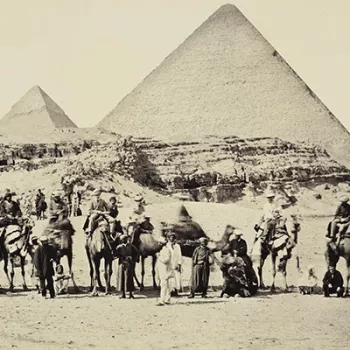Travelling service with later additions
9880.0 g (Weight) (whole object) | RCIN 43936
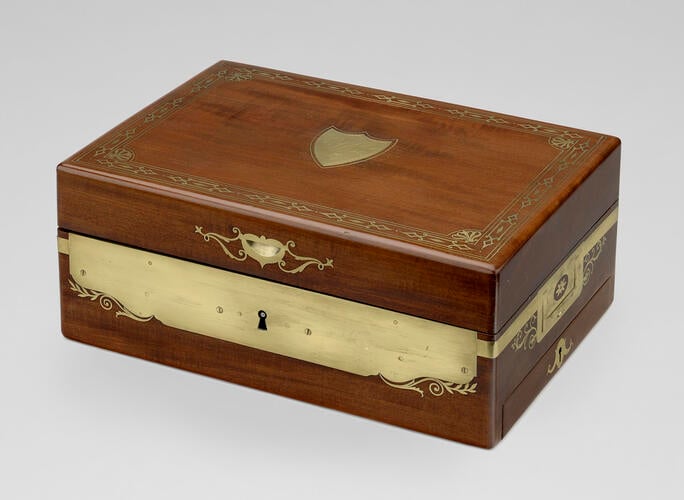
Martin Guillaume Biennais (1764–1843)
Travelling service with later additions
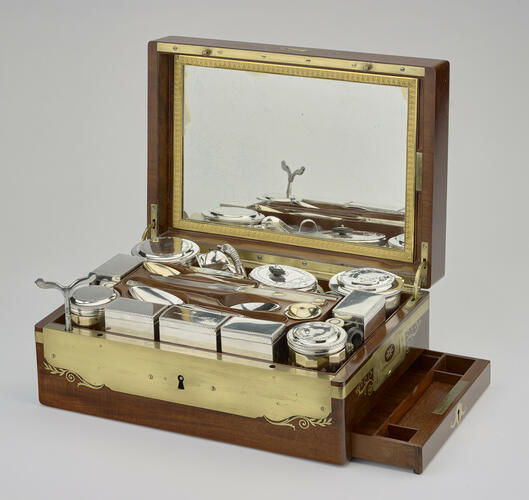
Martin Guillaume Biennais (1764–1843)
Travelling service with later additions
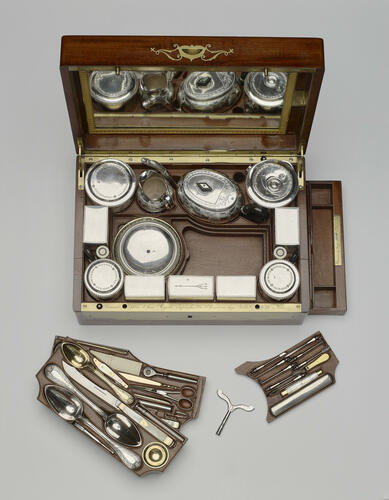
Martin Guillaume Biennais (1764–1843)
Travelling service with later additions
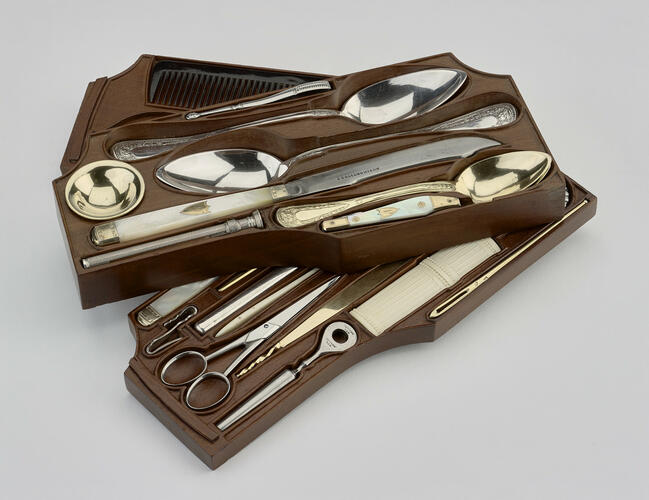
Martin Guillaume Biennais (1764–1843)
Travelling service with later additions

Martin Guillaume Biennais (1764–1843)
Travelling service with later additions
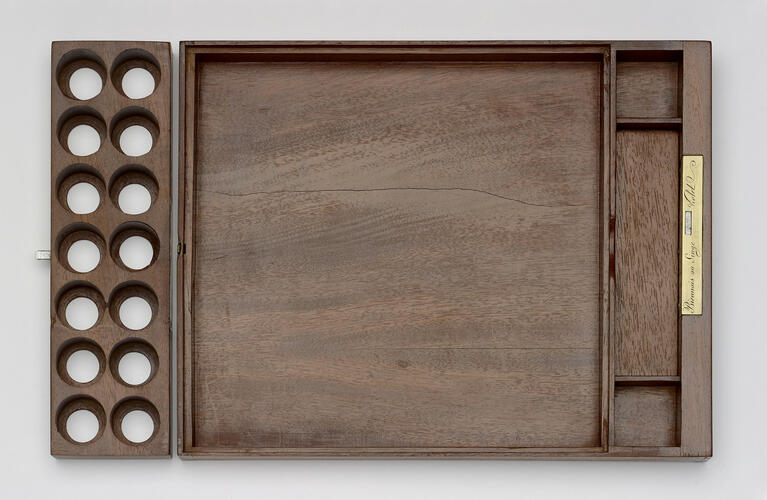
Martin Guillaume Biennais (1764–1843)
Master: Travelling service with later additions
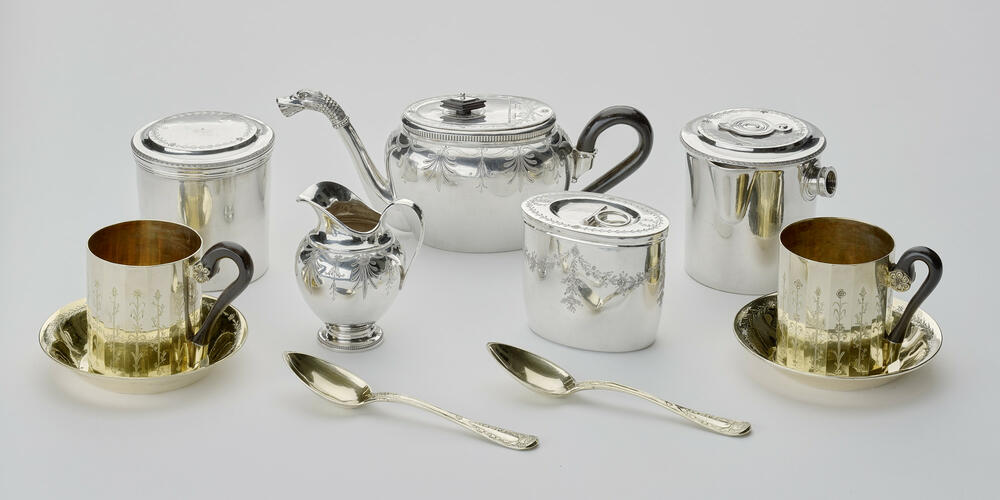
Martin Guillaume Biennais (1764–1843)
Travelling service with later additions

Martin Guillaume Biennais (1764–1843)
Travelling service with later additions









-
A silver and silver-gilt travelling service in a mahogany and brass-bound box, the lid inset with a brass shield engraved with the SN monogram of Stéphanie Napoleon (Stephanie de Beauharnais). The box has brass carrying handles and is fitted with bolts for securing to a surface during travel. The interior of the lid is fitted with a mirror; the box contains removable trays containing equipment for making tea, coffee and chocolate, dressing, dental tools and sewing materials, all carefully fitted into the space. There is a drawer to one side, containing a coin holder and compartmented section with a detachable wooden lid, probably for jewellery. The box is marked 'Biennais Orfèvre de leurs Majestés Impériales, Rue St Honoré au Singe Violet No. 121 à Paris'.
Martin Guillaume Biennais (1764–1843) was originally a cabinet maker and tabletier (dealer and maker of small objects) with, by 1789, established premises at 283 rue St Honoré 'Au Singe violet' (At the Sign of the Purple Monkey). With the ending of guild restrictions following the passing of the Chapelier laws in 1791 Biennais diversified his business to include the production of silver and gilt items. He supplied Napoleon Bonaparte and his family from as early as 1798 including, in 1804, the Emperor's crown and sceptre for his coronations in Paris and Milan. After 1804, he marked his objects 'Goldsmith to Napoleon' or 'First Goldsmith to the Emperor'.
Biennais also supplied many of the silver and gilt items to the partnership of Charles Percier and Pierre François Léonard Fontaine, designers of residences for the Emperor including Malmaison and Fontainebleu. In addition he supplied other royal houses in Russia, Austria and Bavaria with silver and silver gilt items. Necessaires came into fashion during the Regence (1715-23) in France to denote a case with fitted compartments containing sets of utensils for tea, coffee and chocolate. By the mid-eighteenth century it was a wider term used for other cases containing toilet services, breakfast sets, needlework and writing equipment and for travel smaller, more convenient articles were accommodated together in a single case. Biennais was the specialist in this field.
Box engraved, Biennais Orfevre de leurs Majestes Imperiales, Rue St Honore au Singe Violet No.121 a Paris; large container and lid (43936.ac-ad), container and lid (43936.n, .p), container and lid with screw-off section (43936.i, .k, .l), chocolate pot and lid, and pair of silver-gilt dishes all struck with fineness mark (.950), guarantee mark (Paris, 1798-1809), mark of the Association des Orfevres, and maker's mark of Biennais; milk jug spout struck with fineness mark (.950), side of neck with guarantee mark (Paris, 1798-1809), base with mark of the Association des Orfevres and maker's mark of Biennais; silver teapot struck on base with fineness mark (.950), guarantee mark (Paris, 1798-1809), mark of the Association des Orfevres and maker's mark of Biennais, lid struck on rim with guarantee mark (Paris, 1798-1809), on underside with fineness mark; oval tea caddy with fineness mark (.950), guarantee mark (Paris, 1798-1809), mark of the Association des Orfevres, and maker's mark of Biennais, lid marked with fineness mark and guarantee mark (Paris, 1798-1809); candlestick struck with fineness mark (.950), guarantee mark (Paris, 1798-1809), mark of the the Association des Orfevres, and maker's mark of Biennais, nozzle struck with fineness mark and guarantee mark (Paris, 1798-1809), the other two marks poorly struck; rectangular silver cannister struck on cover with fineness mark, on inner and outer rim of cover with guarantee mark (Paris, 1798-1809), on inside of cover with mark of the Association des Orfevres, and maker's mark of Biennais; four rectangular silver replacment cannisters all sruck on lid with lion passant, date letter for 1860/1, and maker's mark of Brownett & Rose, all struck on side with lion passant, leopard's head, duty mark, date letter for 1860/1, and maker's mark of Brownett & Rose; two tablespoons struck with fineness mark (.800), guarantee mark (Paris, 1798-1809), and maker's mark of Lorillon; knife (43936.bq) struck with fineness mark (.950), guarantee mark (Paris, 1798-1809), and maker's mark of Biennais; two pairs of steel scissors stamped, SAVIGNY & CO; stainless steel corkscrew and detachable handle stamped twice, SAVIGNY & Co; ivory toothbrush struck, ASPREY 166 BOND STREET; faceted silver-gilt cups both struck on base with fineness mark, mark of of the Association des Orfevres, and maker's mark of Biennais, on side with guarantee mark (Paris, 1798-1809); knife (43936.bx) blade struck with fineness mark (.800), guarantee mark (Paris, 1798-1809),and maker's mark of Biennais; knife (43936.by) blade stamped, AU SINGE VIOLET; glove stretchers' loop struck with fineness mark, guarantee mark (paris, 1798-1809), and maker's mark of Biennais; bodkin struck with small guarantee mark (Paris, 1798-1809) and maker's mark, [...] G/S; pair of silver-gilt teaspoons both struck with guarantee mark (Paris, 1798-1809), fineness mark (.800), and maker's mark of Lorillon; tongue scraper struck with small guarantee mark (Paris, 1798-1809).Provenance
This service was part of the enormous trousseau provided by Napoleon Bonaparte to his adopted daughter Stephanie de Beauharnais on her marriage to Grand Duke Carl Ludwig Frederick of Baden. Napoleon is known to have spent 6,500 livres on a single necessaire from the Biennais workshops, so this service must have formed a considerable percentage of the whole dowry. The service passed, with many other items from Stephanie's collections to her daughter, Princess Marie Amelie, wife of the 11th Duke of Hamilton, although it must at some point in the nineteeth century have lost a number of articles, as various pieces in the service are now replacements, with English hallmarks for 1860/1.
Purchased by Queen Mary at the sale of Lady Mary Douglas Hamilton's property, Sotheby's, London, 13 December 1934, lot 2. -
Creator(s)
(nationality)Acquirer(s)
-
Measurements
9880.0 g (Weight) (whole object)




